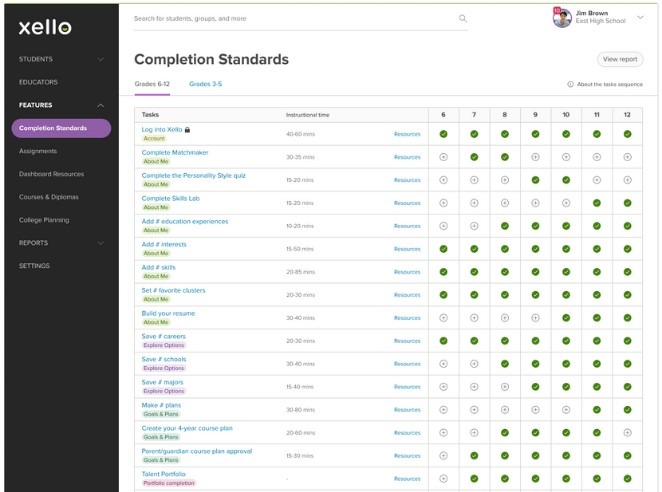A Smooth Path to Success: 5 Tips for Guiding Students Through Critical Transitions

1. Encourage Self-Awareness
Nurturing a culture of introspection is crucial in helping students navigate transitions. By encouraging self-reflection, educators can empower students to gain a deeper understanding of their strengths, weaknesses, and learning preferences. This self-knowledge becomes the foundation for setting realistic goals and developing strategies for success in new environments.
One effective way to promote self-reflection is to ask students to assess their own strengths and weaknesses. This can be done through self-assessment surveys, discussions, or journaling. By identifying their strong suits and areas for improvement, students can set realistic goals for themselves and take ownership of their learning journey.
Discovery and Growth
Another important aspect of self-reflection is encouraging students to think about their learning styles and preferences. How do they best absorb and retain information? Do they prefer hands-on activities, visual aids, or auditory explanations? Understanding their preferred learning styles can help students adapt to new learning environments and optimize their learning strategies.
Finally, journaling or writing letters to oneself provides a powerful outlet for students to process their thoughts, feelings, and experiences during critical transitions. This practice encourages self-expression, self-awareness, and emotional regulation. By reflecting on their written entries, students can gain insights into their own growth and development, cultivating a sense of accomplishment and resilience.
2. Provide Real-Life Examples
Real-life examples are indispensable in illustrating the challenges students may encounter during change and transitions. These examples can range from scenarios and case studies to anecdotes from educators and students who have successfully navigated such transitions. Educators can begin by presenting hypothetical scenarios that reflect common challenges students might face when moving to a new grade level.
Equipping students with problem-solving and decision-making skills empowers them to navigate challenges independently and make informed choices. Educators can provide opportunities for students to practice these skills through real-life scenarios and collaborative activities. By engaging in these experiences, students develop the critical thinking and problem-solving abilities necessary to thrive in their academic and personal lives.
The Voice of Experience
Case studies offer a more in-depth examination of real-life transitions. Educators can share success stories of students who have effectively managed critical transitions, highlighting the specific skills and strategies they employed. These success stories can serve as a source of inspiration and motivation for students facing similar challenges, demonstrating that successful navigation of critical transitions is achievable.
Anecdotes from educators and students provide a personal touch, allowing students to connect with the experiences of others. Educators can share their own stories of overcoming challenges during critical transitions, emphasizing the lessons they learned and how they applied those lessons in their professional lives. Similarly, students can share their experiences of successfully working through other critical transitions, providing valuable insights and strategies for their peers.
3. Help Build Resilience and Coping Skills
Resilience and coping skills are essential tools for students as they navigate the challenges of transitions. Cultivating a growth mindset is pivotal, where setbacks are viewed as stepping stones to success rather than insurmountable barriers. By reframing challenges as opportunities, students develop the tenacity to persevere in the face of adversity.
Self-compassion plays a vital role in developing resilience. Encouraging students to treat themselves with kindness and understanding, rather than harsh self-criticism, creates a supportive inner dialogue that bolsters their confidence and ability to bounce back from setbacks. Techniques such as deep breathing and meditation can also be taught to help students manage stress and anxiety, equipping them with practical tools for emotional regulation.
Create a Safe Space
Building resilience and coping skills requires a supportive environment where students feel safe to take risks, make mistakes, and learn from their experiences. Educators can create such an environment by fostering a positive classroom climate, encouraging open communication, and celebrating students’ efforts and accomplishments. By nurturing resilience and coping skills from an early age, we empower students to embrace change with confidence, adaptability, and a zest for continuous growth.
It is crucial for educators to recognize the unique challenges that students may face during transitions, such as high school seniors preparing for college or younger students transitioning from elementary school to middle school. Tailoring support to address these specific concerns can make a significant difference in helping students successfully navigate their world and growth.
By implementing these strategies and providing a supportive environment, educators can effectively prepare students for successful transitions, helping them develop the resilience and coping skills necessary for academic success and personal well-being throughout their school years and beyond.
4. Nurture Self-Management
Self-regulation is a crucial skill that empowers students to manage their emotions, behaviors, and thoughts effectively. Incorporating mindfulness techniques, such as breathing exercises, into the school day can significantly reduce stress and anxiety levels, enabling students to approach transitions with a calmer and more focused mindset.
Teaching students to set realistic goals and break them down into smaller, achievable steps provides a sense of control and accomplishment, boosting their confidence as they progress through critical transitions.
This is where the village is needed
Encouraging students to seek support from teachers, counselors, or other students when feeling overwhelmed or struggling strengthens a sense of community and belonging. Providing opportunities to practice self-regulation skills in a supportive environment, such as through group activities or individual check-ins, reinforces these skills and promotes their application in various situations.
Educators can serve as powerful role models by demonstrating these skills in their interactions with students. By displaying emotional control, managing stress, and making thoughtful decisions, educators set an example for students, inspiring them to adopt similar behaviors.
By integrating self-regulation into the educational experience, students develop essential skills that will serve them well throughout their academic careers and personal lives.
5. Champion Confidence
The transition from middle to high school can be daunting for students, but by implementing effective strategies, schools can help ease this transition and ensure students’ success. One key strategy is addressing the differences in academic expectations and workload. High school courses often require more independent learning, critical thinking, and time management skills.
To prepare students for this change, middle schools can introduce projects and assignments that gradually increase in complexity, encouraging students to develop these essential skills. Teachers can also provide explicit instruction in study skills and time management techniques, such as creating a study schedule, setting priorities, and breaking down large tasks into smaller, manageable steps.
Forming effective time management and organizational skills is also crucial for high school success. High school students often have multiple classes, assignments, and extracurricular commitments, which can be overwhelming if not managed effectively. Schools can help students develop these skills by providing workshops on time management strategies, such as setting priorities, creating to-do lists, and using digital tools for organization.
Additionally, teachers can encourage students to practice these skills by setting clear expectations for assignments, due dates, and class participation. By mastering time management and organizational skills, students can reduce stress and increase their chances of success in high school.
It’s not just the academics
Another important aspect of a successful transition to high school is helping students navigate the social and emotional changes that come with this new phase. High school students may experience increased social pressure, peer influence, and stress. To support students in managing these challenges, schools can offer counseling services, peer mentoring programs, and social-emotional learning curricula. Encouraging students to participate in extracurricular activities, such as clubs, sports, and community service, can also help them feel a sense of belonging, develop leadership skills, and make positive connections with their peers.
Setting Students Up for Success
Guiding students through critical transitions requires a thoughtful and holistic approach. These strategies will not only support students in navigating the challenges of new academic environments but also help create a lifelong ability to adapt to change and face future transitions with confidence. By prioritizing these approaches, educators can play a pivotal role in shaping a positive and successful educational journey for their students, ensuring they are well-prepared for both academic and personal growth.



